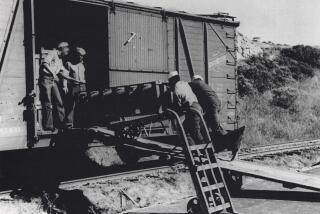Convoy Veterans Recall Murmansk Run
- Share via
MURMANSK, Soviet Union — Three Americans who survived the hazardous convoys to Murmansk in World War II came back Thursday to honor the memory of those who went down with their ships in the frigid Arctic waters.
They also placed flowers and tiny American flags on the graves of three American seamen who died of their wounds in a Murmansk hospital.
Standing with their heads bared in a hillside cemetery, they listened to a prayer offered by the Rev. Arthur R. Bartlett, chaplain of the Episcopal Seamen’s Center in San Pedro, Calif.
“Thank God for their valiant efforts, and to know that they have crossed the bar and reached the port of Our Lord,” Bartlett said of the merchant sailors who did not make it to Murmansk.
Relatively few Americans visit this city. It lies about 1,200 miles north of Moscow and claims to be the largest city north of the Arctic Circle. But about two years ago Arthur A. Hartman, then the U.S. ambassador to the Soviet Union, came here to cast a wreath into Kola Bay in memory of the Americans who gave their lives on the Murmansk run. He also visited the Allied military cemetery where a few dozen British, American and Polish sailors are buried.
Walter MacLaren of Mesa, Ariz., who arrived in Murmansk with a convoy of Allied ships in February, 1944, said: “It almost brings tears to your eyes to see this city. When we saw it before, it was desolated.”
Donald G. Gibbs, a friend whose ship fought its way to Murmansk in the winter of 1943-44, agreed, saying: “To come back here--it’s pretty emotional, if you understand what we went through to get here the first time. We were bombed, strafed and torpedoed.”
It was a somber moment not only for the American survivors but for Soviet veterans who joined in the tribute.
“I started to cry,” said Richard G. Connelly of Los Angeles, who escaped attack in one convoy but whose ship went down on his second trip.
22 Ships Sunk
He was an ordinary seaman, 18 years old, when he took part in the massive Allied effort to move tanks, planes, food and other supplies to the embattled Soviet Union. Now, wearing a grizzled beard, Connelly fought back tears as he thought of long-lost shipmates.
He sailed with Convoy PQ-17 in July, 1942, a time when German U-boats stalked the routes to Murmansk. Of 33 ships that set out with Convoy PQ-17, 22 were lost to enemy action.
Connelly, Gibbs and MacLaren were joined by friends and relatives for the pilgrimage. The Americans were greeted warmly by the chairman of the Murmansk City Council, Vladimir I. Goruatshkin, who was a child during the war.
Goruatshkin said that 722 Allied ships in 42 convoys arrived in Murmansk and two other Soviet ports in the period 1941-45, and that 36 convoys left the Soviet Union carrying raw materials. Of all these ships, he said, 85 were lost.
Murmansk was so heavily bombed by the Germans, he said, that no building was undamaged.
“People were touched that the American sailors brought their wives and even some kids,” he said of Thursday’s visit. “Let our kids know, too, what we had to live through. Another war is not needed by the Soviet or the American people.”
This theme was sounded later at a meeting between the Americans and some Soviet veterans. Connelly, addressing the meeting at the International Seamen’s Club, said:
“We’re here to remember our departed comrades . . . those who are buried here and the many, many more who are on the bottom of the Barents Sea. We never want our sons or our grandsons to go through the same. We are going to work hard for peace because if there is another war, there will be no survivors.”
Murmansk is open to shipping all year because Kola Bay, which is warmed by the Gulf Stream, never freezes over. But it was chilly in the city Thursday, even though the Soviet welcome was warm.
More to Read
Sign up for Essential California
The most important California stories and recommendations in your inbox every morning.
You may occasionally receive promotional content from the Los Angeles Times.













